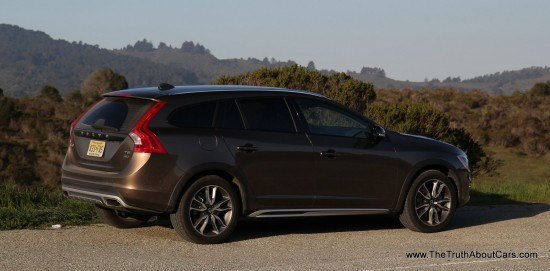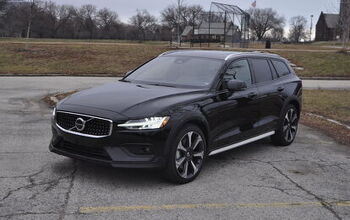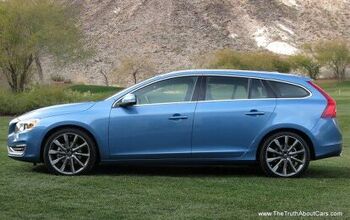Review: 2015.5 Volvo V60 Cross Country (with Video)

Volvo may not have invented the wagon but no company has as much dedication to the practical cargo hauler as the Swedish brand. With the new V60 Cross Country they have expanded to six wagons world-wide (V40, V40 Cross Country, V60, V60 Cross Country, V70 and XC70). Wagon fans sad that Volvo isn’t bringing their smaller boxes to the USA may be relieved to know the V60 Cross Country is not replacing the V60. This means that for the first time in a long time, we have access to three Swedish wagons on our shores.
Exterior
Volvo is a company normally associated with safety and practicality. They are the comfy penny loafer of the luxury segment if you will. This Volvo is different. Rather than the boxy form-follows-function style we’re used to from Sweden, the V60 is more about style than practicality. The change is most noticeable in the rear where we get a hatch that is raked forward and a greenhouse that plunges and pinches toward the back. e still have a subtle hint of the Volvo “hips”, but the design has been smoothed and simplified since the 1999 S80 that started Volvo’s modern style.
For off-paved-road duty, Volvo jacked up V60’s ride height by 2.6 inches, added some silver trim here and there, swapped out the grille for a honeycomb-themed version and added some black wheel arches. Thus the oddly named V60 Cross Country was born. For reasons I don’t quite understand, the CC gets larger wheels (18-inch) narrower 50-series rubber. This should be your first hint that the CC is more soft-road than off-road focused. As you might expect from a car maker located in the north, the CC can be had with an electric heated windscreen ala Range Rover that speeds ice removal when the snowpocalypse returns. Perhaps it’s my preference towards wagons in general, but I think the the tweaks work on the CC, it retains the crisp style I appreciate on the V60 but adds just enough “rugged” style to differentiate it on the road.
Interior
For those that haven’t shopped for a Volvo wagon in a while, the Swedes continue to shuffle model numbers around. Once upon a time the wagon variant of the S60 was the V70 and the off-road version was the XC70. Today however the V70 and XC70 are based on the S80 wagon. The V50 was once the wagon version of the smaller S40 leaving just V60 available. Sounds logical, right? So an off-road modified V60 would be a XC60. Oops, that already exists. So Volvo dusted off their older “Cross Country” nomenclature, the same trim that ostensibly got shortened to “XC” a while back. Confused yet?
The V60’s is on the small side for this segment and that’s most noticeable in the rear where we have less legroom than you’ll find in the A4 and BMW 3-Series wagons. This is the key reason that Volvo will be bringing their stretched S60 sedan to America next year, sadly there is no word of a matching V60L. Front seat accommodations are spacious, but still offer a less room than the Germans. One thing Volvo has consistently excelled at however is seat comfort. Front and rear seats are well padded and extremely comfortable. All 2015.5 Volvo models finally ditch the lumbar support knob for a 2-way power variety which is welcome, but not as adjustable as the 4-way competition. In an interesting twist, all CC models get a variant of the S60 and V60’s sport seats which offer exaggerated bolstering on the back and bottom cushions. I like the feel, but if you’re a larger person you may find them a little narrow.
The cargo area is where we see the consequence of Volvo’s sexy side profile. Behind the curvaceous hatch sits half the cargo capacity of an XC60 at just 15.2 cubic feet. With the rear seats folded it expands to 43.5, about half of what you find in the XC70. The cargo space is small enough that even the questionably practical BMW X4 has a little more room in the back. Audi’s allroad slots between the XC70 and V60 Cross Country in overall dimensions and cargo capacity.
Infotainment
2015.5 doesn’t bring a larger screen or major UI changes to Volvo’s Sensus Connect but it does add a cell modem. The new “Connected” Sensus gives the driver access to online business searches, streaming media without a smartphone, OnStar-like telematics services (Volvo On Call) and access to Wikipedia. The service requires a data subscription to use the full range of services, but wisely Volvo decided to toss in a WiFi chipset so you can share your cell plan with passengers or use a paired smartphone for Sensus’ data connection if you’d rather not have another cell phone bill. Also along for the ride is a smartphone app to let you see if you locked your car, remote start the engine, or honk the horn and flash the lights if you’ve lost your car in the IKEA parking lot.
Volvo’s Sensus system continues to keep up with most of the entries in this segment by adding features to their snappy interface. The system is well laid out, intuitive, and oddly Volvo allows access to essentially everything while the vehicle is in motion. This allows passengers to enter information using the on-dash control-wheel without stopping the car. The driver can use the same knob, or a control wheel on the steering wheel to control system functions. The graphics, maps and voice commands aren’t quite as well done as iDrive and you can’t voice command your media library as you can in an Acura or Lincoln, but it is competitive with A3’s and allroad’s MMI and COMAND in the CLA and GLA.
Drivetrain
Volvo’s slick 300HP turbocharged/supercharged engine is sadly incompatible with the V60’s AWD system. (The output to the rear axle is located in a different spot and would require modifications to the chassis.) As a result, all 2015.5 Volvos with AWD use the company’s trued and true 5 and 6-cylinder engines and older 6-speed automatic. For CC duty, Volvo limits your engine choice to just the 250 HP 2.5L 5-cylinder engine which can crank out up to 295 lb-ft in overboost for a limited time. If you’d like Volvo’s smooth inline-6 turbo, you’ll have to step over to the regular V60 or the XC70. Thankfully Volvo chose to leave the anaemic 3.2L engine out of the V60’s engine compartment.
2015.5 beings new shift logic to the transaxle that significantly reduces shift time (and sacrifices some shift quality) when in “sport” mode. Despite receiving some efficiency tweaks a few years ago, the 2.5L’s fuel economy still lags behind the 3-Series wagon at 23 MPG combined. Sending power to the rear is the latest Haldex AWD system which can send up to 50% of the power to the rear axles at any time, and if wheel slip up front occurs the power transfer can exceed 90%.
Drive
The new programming of the AWD and transmission in sport mode was instantly obvious behind the wheel compared to 2014 S60 T5 AWD I benchmarked back-to-back. The new AWD software sends noticeably more power to the rear when flogging the CC on winding roads and transmission shifts are considerably faster and firmer. The change in programming isn’t just about feel, it also took a quarter second off the 0-60 time without an increase in power. The Aisin 6-speed transaxle in Volvo’s product-line has always felt soft compared to the ZF 6-speeds that BMW and Audi used, but this software narrows the gap. The improved bundle scoots to 60 in 6.41 seconds, just under 3/10ths slower than a X4 xDrive28i (that review is coming up soon.)
With the V70 to XC70 transition the engineers softened the suspension, but they took a different path with the CC making this one of the firmer almost-crossover vehicles around. The suspension is more forgiving than the V60 R-Design, but significantly stiffer than the larger XC70 or the Audi allroad. This leads to impressive handling when compared to the allroad, XC70 or even the distant Subaru competition. Something along the lines of a BMW X4 or BMW 328i GT will feel more nimble without a doubt, but they are also significantly more expensive.
On the surface of things it would seem that the $41,000 V60 Cross Country commands a $4,000 premium over the V60, XC60 or XC70. That sounded logical to me at first, since BMW charges roughly the same to make the X3 less practical create the X4 from the X3. However, when you adjust for the standard AWD, 18-inch wheels, navigation, sport seats, LDS gauges, etc the CC actually ends up being slightly less than a comparable V60 and $1,500 less than the XC70 3.2. (Speaking of the XC70 and the 3.2, Volvo’s big wagon has a confusing engine line-up. Opt for FWD and you get their sweet four-cylinder turbo and new 8-speed auto. Get the middle-trim and you’re saddled with a wheezy naturally aspirated 3.2L engine, but pony up a little extra and you can get the same BMW-fighting twin-scroll turbo 3.0L engine as the V60 R-Design.)
Audi’s allroad is several thousand dollars more than the CC when similarly equipped and is even a slight premium over the XC70 despite being smaller. The rugged Audi handles well, but the Volvo weighs several hundred pounds less and that more than compensates for the less advantageous weight balance in the corners. While the BMW X4 and 3-Series GT may deliver superior handling, they also come with a superior price tag. A comparable X4 xDrive28i will set you back at least $8,000 more.
The Audi allroad and the Volvo XC70 are made for rural living with a Euro twist. The soft suspensions soak up poor pavement in the boonies, the AWD systems are sure-footed on dirt roads and you won’t bruise your kidneys if you decide to drive off the beaten path to check on your trendy alpaca herd. The V60 Cross Country has a different mission in mind. Like the X4 and 3-Series GT, this Volvo was made for folks that live down a short gravel road but drive on high-speed winding mountain roads for most of their commute. In other words, my demographic exactly.
Trouble is, as much fun as the Cross Country was to drive, and how perfectly it seemed tailored to my demographic, the XC60 or the XC70 make considerably more sense. Part of that has to do with the V60’s position as a “styling exercise” than a practical cargo hauler. The XC60 gives up less handling ability than you’d think with twice the cargo capacity and the XC70 gives you more thrust, more luxury, and, again: twice the cargo capacity. The 2015.5 V60 Cross Country is one of the best wagons ever sold in America, but I’d buy a XC70 T6 instead.
Volvo provided the vehicle, insurance and one tank of gas for this review
Specifications as tested:
0-30: 2.5 Seconds
0-60: 6.41 Seconds
1/4 Mile:15 Seconds @ 92 MPH
Average Fuel Economy: 22 MPG

More by Alex L. Dykes
Latest Car Reviews
Read moreLatest Product Reviews
Read moreRecent Comments
- Jalop1991 Is this the beginning of the culmination of a very long game by Tesla?Build stuff, prove that it works. Sell the razors, sure, but pay close attention to the blades (charging network) that make the razors useful. Design features no one else is bothering with, and market the hell out of them.In other words, create demand for what you have.Then back out of manufacturing completely, because that's hard and expensive. License your stuff to legacy carmakers that (a) are able to build cars well, and (b) are too lazy to create the things and customer demand you did.Sit back and cash the checks.
- Buickman more likely Dunfast.
- Chris P Bacon "Dealership". Are these traditional franchised dealers, or is Vinfast selling direct?
- Chris P Bacon Full self driving is a fraud. Even aircraft "autopilot" requires pilot interaction, attention, and most importantly of all, training is required. We've already seen accidents by idiots who think they don't need to interact with their Tesla. The system gets confused by simple lane markings, and there are many more variables driving down the street than there is in a jet aircraft.
- ToolGuy I read through the Tesla presentation deck last night and here is my take (understanding that it was late and I ain't too bright):• Tesla has realized it has a capital outlay issue and has put the 'unboxed' process in new facilities on hold and will focus on a 'hybrid' approach cranking out more product from the existing facilities without as much cost reduction but saving on the capital.They still plan to go 'all the way' (maximum cost reduction) with the robo thing but that will be in the future when presumably more cash is freed up.








































































![2016 Volvo S60 Cross Country Review – The Sport Utility… Sedan? [Video]](https://cdn-fastly.thetruthaboutcars.com/media/2022/07/19/9239227/2016-volvo-s60-cross-country-review-the-sport-utility-sedan-video.jpg?size=350x220)












Comments
Join the conversation
As usual, the other CUV/Cross-Country/AWD products in the Volvo lineup are A) too expensive for what they are and B) outclassed in luxury and practicality by the XC70. That being said, many of the options you find on luxury vehicles are -not- available on the XC70, and that's disappointing. No cooled seats, no rear heated seats, no panoramic roof, no radar cruise control until maybe very recently, no keyless start (must put fob in dash).
My wife was recently looking to replace her'06 V70 R MT (yeah- that was a great car for 8 years). Largely agree with this review but we were looking more at the V60 T5. Nice car, great seats, strong motor, cool design, pathetic cargo area, somewhat overpriced (not hugely). Then the salesman mentioned an XC60 R-Design he just took in trade. Done and done. 325HP, sport suspension takes corners way flatter than it has a right to given the ground clearance, nice interior (a step behind this car), great back seat, good cargo area (if still far shy of the old V70), great value. My wife is thrilled. Volvo should take the the V60 drivetrains and put them in compact coupes and 5-door hatches, made in China and branded separately (but sold through existing dealers), a la Scion to Toyota. They could sell many, many units.